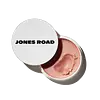What's inside
What's inside
 Key Ingredients
Key Ingredients

 Benefits
Benefits

 Concerns
Concerns

 Ingredients Side-by-side
Ingredients Side-by-side

Ricinus Communis Seed Oil
MaskingBeeswax
Emulsion StabilisingCastor Isostearate Succinate
Skin ConditioningCaprylic/Capric Triglyceride
MaskingDiisostearyl Malate
EmollientCaprylic/Capric/Myristic/Stearic Triglyceride
EmollientCoconut Alkanes
EmollientBrassica Campestris/Aleurites Fordi Oil Copolymer
Skin ConditioningHydrogenated Castor Oil
EmollientSimmondsia Chinensis Seed Oil
EmollientArgania Spinosa Kernel Oil
EmollientZingiber Officinale Root Oil
MaskingCitrus Grandis Peel Oil
MaskingCitrus Aurantium Dulcis Peel Oil
MaskingHippophae Rhamnoides Fruit Oil
Skin ProtectingRosmarinus Officinalis Leaf Oil
MaskingPelargonium Graveolens Oil
MaskingSynthetic Fluorphlogopite
Tocopheryl Acetate
AntioxidantCoco-Caprylate/Caprate
EmollientPhenoxyethanol
PreservativeTin Oxide
AbrasiveMica
Cosmetic ColorantCI 77891
Cosmetic ColorantCI 77491
Cosmetic ColorantCI 45410
Cosmetic ColorantLimonene
PerfumingLinalool
PerfumingCitral
PerfumingRicinus Communis Seed Oil, Beeswax, Castor Isostearate Succinate, Caprylic/Capric Triglyceride, Diisostearyl Malate, Caprylic/Capric/Myristic/Stearic Triglyceride, Coconut Alkanes, Brassica Campestris/Aleurites Fordi Oil Copolymer, Hydrogenated Castor Oil, Simmondsia Chinensis Seed Oil, Argania Spinosa Kernel Oil, Zingiber Officinale Root Oil, Citrus Grandis Peel Oil, Citrus Aurantium Dulcis Peel Oil, Hippophae Rhamnoides Fruit Oil, Rosmarinus Officinalis Leaf Oil, Pelargonium Graveolens Oil, Synthetic Fluorphlogopite, Tocopheryl Acetate, Coco-Caprylate/Caprate, Phenoxyethanol, Tin Oxide, Mica, CI 77891, CI 77491, CI 45410, Limonene, Linalool, Citral
Aloe Barbadensis Leaf Juice
Skin ConditioningCoconut Alkanes
EmollientCaprylyl Methicone
Skin ConditioningPolyglyceryl-6 Polyricinoleate
EmulsifyingCetearyl Isononanoate
EmollientPolyglyceryl-2 Isostearate
EmulsifyingBoron Nitride
AbsorbentDimethicone
EmollientDisteardimonium Hectorite
StabilisingNiacinamide
SmoothingOryza Sativa Hull Powder
AbrasiveGluconolactone
Skin ConditioningSodium Chloride
MaskingIsopentyldiol
HumectantGlycerin
HumectantCoco-Caprylate/Caprate
EmollientAllantoin
Skin ConditioningSodium Benzoate
MaskingCaprylic/Capric Triglyceride
MaskingSimmondsia Chinensis Seed Oil
EmollientSclerocarya Birrea Seed Oil
HumectantSqualane
EmollientTocopherol
AntioxidantPentylene Glycol
Skin ConditioningTriethoxycaprylylsilane
Pistacia Lentiscus Gum
MaskingHydrogenated Lecithin
EmulsifyingCalcium Gluconate
HumectantEthylhexylglycerin
Skin ConditioningJasminum Officinale Flower/Leaf Extract
MaskingPhenethyl Alcohol
MaskingBisabolol
MaskingCI 77891
Cosmetic ColorantCI 77491
Cosmetic ColorantCI 77492
Cosmetic ColorantCI 77499
Cosmetic ColorantAloe Barbadensis Leaf Juice, Coconut Alkanes, Caprylyl Methicone, Polyglyceryl-6 Polyricinoleate, Cetearyl Isononanoate, Polyglyceryl-2 Isostearate, Boron Nitride, Dimethicone, Disteardimonium Hectorite, Niacinamide, Oryza Sativa Hull Powder, Gluconolactone, Sodium Chloride, Isopentyldiol, Glycerin, Coco-Caprylate/Caprate, Allantoin, Sodium Benzoate, Caprylic/Capric Triglyceride, Simmondsia Chinensis Seed Oil, Sclerocarya Birrea Seed Oil, Squalane, Tocopherol, Pentylene Glycol, Triethoxycaprylylsilane, Pistacia Lentiscus Gum, Hydrogenated Lecithin, Calcium Gluconate, Ethylhexylglycerin, Jasminum Officinale Flower/Leaf Extract, Phenethyl Alcohol, Bisabolol, CI 77891, CI 77491, CI 77492, CI 77499
 Reviews
Reviews

Ingredients Explained
These ingredients are found in both products.
Ingredients higher up in an ingredient list are typically present in a larger amount.
This ingredient is an emollient, solvent, and texture enhancer. It is considered a skin-softener by helping the skin prevent moisture loss.
It helps thicken a product's formula and makes it easier to spread by dissolving clumping compounds.
Caprylic Triglyceride is made by combining glycerin with coconut oil, forming a clear liquid.
While there is an assumption Caprylic Triglyceride can clog pores due to it being derived from coconut oil, there is no research supporting this.
Learn more about Caprylic/Capric TriglycerideCi 77491 is also hydrated iron III oxide. It's sole purpose is to give a red/pink hue to products.
Iron III oxides are classified as inorganic chemicals for coloring.
Synthetically created Ci 77491 is considered safer than those naturally found. This is because the synthetically created version may contain less impurities. Iron oxides are generally non-toxic and non-allergenic.
Learn more about CI 77491Ci 77891 is a white pigment from Titanium dioxide. It is naturally found in minerals such as rutile and ilmenite.
It's main function is to add a white color to cosmetics. It can also be mixed with other colors to create different shades.
Ci 77891 is commonly found in sunscreens due to its ability to block UV rays.
Learn more about CI 77891Coco-Caprylate/Caprate is created from fatty coconut alcohol, caprylic acid, and capric acid.
It is a lightweight emollient. Emollients create a thin barrier on the skin to trap moisture in. This helps keep your skin hydrated and soft.
Once applied, Coco-Caprylate/Caprate is absorbed quickly and leaves a silky feel.
Coco-Caprylate/Caprate may not be fungal acne safe.
Learn more about Coco-Caprylate/CaprateCoconut Alkanes is created from the fatty-acids of coconut oil. It is volatile, meaning it evaporates from the skin.
This ingredient is an emollient and solvent. As an emollient, it helps keep skin soft and hydrated. Solvents help distribute and mix other ingredients. This ensures a more even consistency.
Coconut Alkanes may not be fungal-acne safe.
Learn more about Coconut AlkanesThis oil comes from the seeds of the desert shrub called Jojoba. It is more commonly known as jojoba oil, a non-comedogenic oil.
Jojoba oil does not contain fragrance and has many fatty-acids, making it a great soothing ingredient.
It also contains Vitamin E, a great moisturizing ingredient. Vitamin E is also an antioxidant and protects your skin against oxidative damage.
This ingredient humectant properties, meaning it helps draw moisture from the air. This helps keep your skin hydrated.
While jojoba has antibacterial properties, it is only able to kill some strains of bacteria.
Studies also show it helps in wound healing. In fact, Indigenous cultures have used jojoba as a moisturizer and to help treat burns for centuries.
Fun fact: Jojoba oil similar to natural human skin sebum, so it has a great effect on dry skin. It is also promising with helping to regulate sebum production.
Due to its fatty acid content, Jojoba oil may not be fungal acne safe. We recommend speaking with a professional if you have any concerns.
Learn more about Simmondsia Chinensis Seed Oil